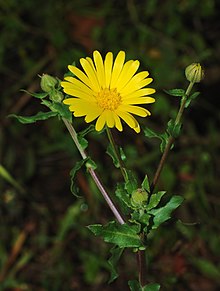| Calendula | |
|---|---|

| |
| field marigold (Calendula arvensis) | |
| Scientific classification | |
| Kingdom: | Plantae |
| Clade: | Tracheophytes |
| Clade: | Angiosperms |
| Clade: | Eudicots |
| Clade: | Asterids |
| Order: | Asterales |
| Family: | Asteraceae |
| Subfamily: | Asteroideae |
| Tribe: | Calenduleae |
| Genus: | Calendula L. |
| Species | |
|
See text | |
| Synonyms[1] | |
| |
Calendula (/kəˈlɛndjuːlə/)[2] is a genus of about 15–20 species[3] of annual and perennial herbaceous plants in the daisy family, Asteraceae that are often known as marigolds.[4]: 771 They are native to southwestern Asia, western Europe, Macaronesia, and the Mediterranean. Other plants known as marigolds include corn marigold, desert marigold, marsh marigold, and plants of the genus Tagetes.
The genus name Calendula is a modern Latin diminutive of calendae, meaning "little calendar", "little clock" or possibly "little weather-glass".[5] The common name "marigold", a contraction of "Mary's gold"[5] refers to the Virgin Mary. The most commonly cultivated and used member of the genus is Calendula officinalis, the pot marigold. Popular herbal and cosmetic products named "Calendula" invariably derive from C. officinalis.
- ^ Calendula L. Plants of the World Online. Retrieved 29 September 2023.
- ^ Sunset Western Garden Book, 1995:606–607
- ^ Calendula. Flora of China.
- ^ Stace, C. A. (2010). New Flora of the British Isles (Third ed.). Cambridge: Cambridge University Press. ISBN 9780521707725.
- ^ a b Shorter Oxford English Dictionary (6th ed.). United Kingdom: Oxford University Press. 2007. p. 3804. ISBN 978-0199206872.